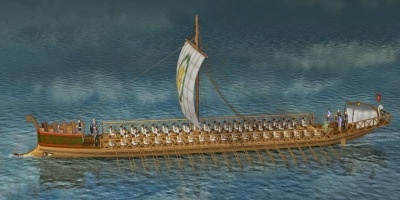Roman Liburnia
Portsmouth Harbour has a very long history of use as a major port. At the north of The Harbour is Portchester Castle, the western most of the Roman Saxon Shore forts built around the Second Century.
The Anglo-Saxon Chronicle tells us baldly that in 501 there was a battle at Portsmouth Harbour in which an important British prince was killed. ‘In this year Port and his sons Breda and Maegla came to Britain at a place called Portsmouth, and slew a young Welshman, a very noble man.’ This has been taken by Morris as a rare instance of the two independent traditions describing the same event. ‘Llongborth’ is not obviously the same place-name as Portsmouth, but it means ‘port of the warships’, which describes the Portsmouth Harbour of those days, and of subsequent centuries, very well. A naval station where a Dumnonian prince fell is likely to be the westernmost Saxon shore fort, Portchester, at the head of Portsmouth Harbour; this is a likely location of the battle of Portsmouth/Llongborth. The Tale tells us that Arthur was there too, as Geraint’s commander-in-chief, and shared in Geraint’s defeat with the ‘men of Devon’.
King Geraint was succeeded by Cato or Cado and both Geraint and Cato, whether father and son, uncle and nephew, or brothers, are remembered in later traditions as close associates of Arthur in war and peace. Geraint held lands on the south Cornish coast, while Cato’s lands lay on the north Devon coast.
The archaeological evidence paints a picture of an alliance between the powerful Jutes (early English) of Kent and the British kings of IW that started at the turn of the 6th Century – as evidenced by the hilltop burial on IW of a (mystical) noble Jutish woman with gold at her head, a (possibly Mithraic) key in her hand, snake ring, and a crystal ball between her legs. Such dynastic linking between Britons and English would be a typical way of normalising relations to allow resumption of coastal trade.
Looking at the sequence of events remembered by the English rather than the dodgy dates they added later(29); Portchester fell to an attack by Saxons and Britons leading to the death of a ‘very’ noble Briton(30), who has been associated with Geraint (a legendary knight of Arthur).
